by Frank Sherwin, M.A., & Brian Thomas, M.S. *
Many creatures appear to be fully integrated mosaics of various features that are shared by otherwise unrelated organisms. For example, hemoglobin is found in all vertebrates, certain earthworms, certain starfish, a selection of clams, some insects, and even in a few bacteria. No evolutionary pattern is discernible, since hemoglobin is distributed sporadically. However, the hemoglobin is integral to each life form that has it, indicating that it was purposefully engineered into each organism, separately.
If big-picture evolution were true, hemoglobin--in fact, all features--ought to be traceable from one kind of creature to the "higher" creatures that it supposedly evolved into. But like the refracting lens eyeball design that is found in vertebrates but also in octopi, features often appear in created mosaic patterns, showing no evolutionary lines of descent.
Certain sea slugs, called "nudibranchs," eat sea anemones and avoid digesting or discharging the anemones' special stinging cells. Somehow, the ultra-sensitive triggers on these cells are not activated as they travel from the nudibranch's gut through special canals to the slug's skin. Amazingly, "there the sea slug stores those stolen weapons to use in its own defence."1 They are then ready to explosively release a microscopic harpoon at the slightest brush of a fish. After the stinging cells are spent for the nudibranch's defense, new ones are added from its next meal.
Similarly, many sea slugs extract intact chloroplasts from algae that they eat. Like the stinging cells, these are transported to projections on the slugs' backs, which are exposed to the sun in shallow ocean waters. The sun's energy is then converted into nutrients that nourish the slugs. In most of these slugs, when the chloroplasts are expended, they are replaced through the consumption of more algae.
Evolution proposes, with absolutely no scientific observation to support it, that a sea slug evolved all of its well-fitting parts--including transparent skin to permit sunlight to enter--and the abilities that enable it to ingest and utilize chloroplasts from its food. Not only that, but evolutionists believe this symbiosis "evolved many times within the nudibranchs with examples in many quite unrelated families and orders."2 Fifteen different species, classified into six different families, of nudibranchs do this. This plant/animal partnership shows no evolutionary lineage and looks like another example of a mosaic feature. As such, it gives every appearance of having been specifically created.
One sea slug in particular, Elysia chlorotica, takes this kind of symbiosis to another level--it has the ability to sustain its acquired chloroplasts for its whole life, about a year. It generates the exact chemicals that its chloroplasts need to keep working, including chlorophyll,3 which is the bright green chemical that collects photons of light for use in the complex process of photosynthesis. Sure enough, just like most plants, this little animal is green. Once it has an initial good meal of algae, all it has to do is sunbathe for the rest of its life.
But chlorophyll construction needs 16 specific enzymes, which must work in concert with other cell components. Evolutionists assume the slug somehow incorporated these genes from algae into its own genome, but that kind of cross-kingdom gene transfer has never been observed and has no known mechanism. Even if it were possible, what are the chances this particular slug would receive just the right genes? Instead, it appears that E. chlorotica has been intentionally designed to produce this chemical.
Did these fascinating partnerships between photosynthetic and stinging-cell sea slugs and their environments develop through evolution? If so, why is that process nowhere to be seen? The great Creator ought to get full credit for designing these remarkable little sea creatures.
References
- Chapman, G. 1992. Sea slugs leave Darwin's theory slipping. Creation. 15 (1): 24-25.
- Rudman, W. B. Solar-powered sea slugs. Sea Slug Forum. Fact sheet, Australian Museum, Sydney. Posted on seaslug-forum.net October 11, 1998, accessed January 15, 2010.
- Milius, S. Green Sea Slug Is Part Animal, Part Plant. Wired Science. Posted on wired.com January 11, 2010, accessed January 13, 2010.
Image © 2008 National Academy of Sciences (used with qualified permission, as a noncommercial and educational use). See Proceedings of the National Academy of Sciences, 2008, 105: 17867-17871 (showing credit to M. E. Rumpho et al). Usage by ICR does not imply endorsement by NAS.
* Mr. Sherwin is Senior Science Lecturer and Mr. Thomas is Science Writer at the Institute for Creation Research.
Cite this article: Sherwin, F. and B. Thomas. 2010. Are Green Sea Slugs the Ultimate Created Mosaic? Acts & Facts. 39 (3): 18.







